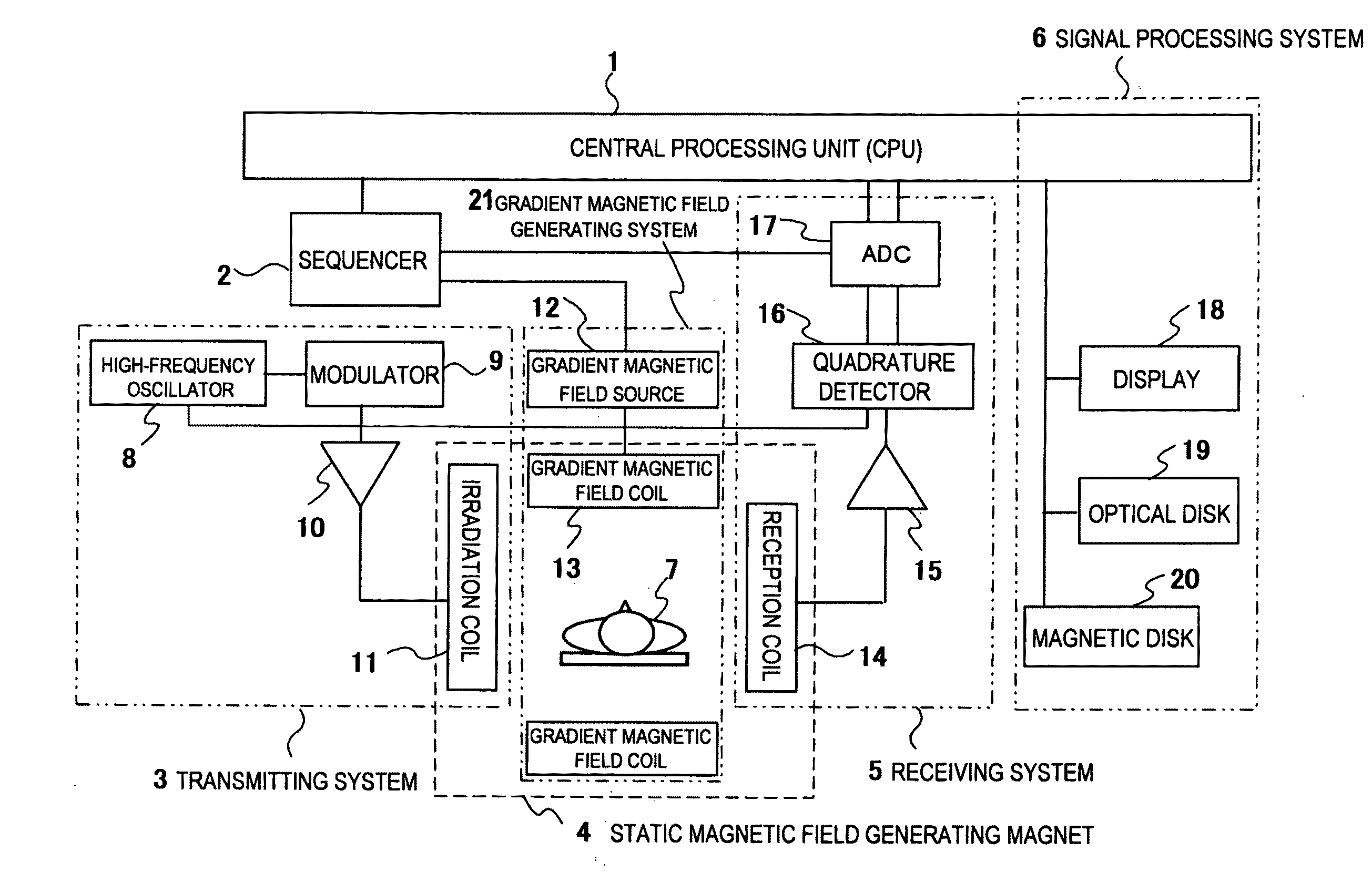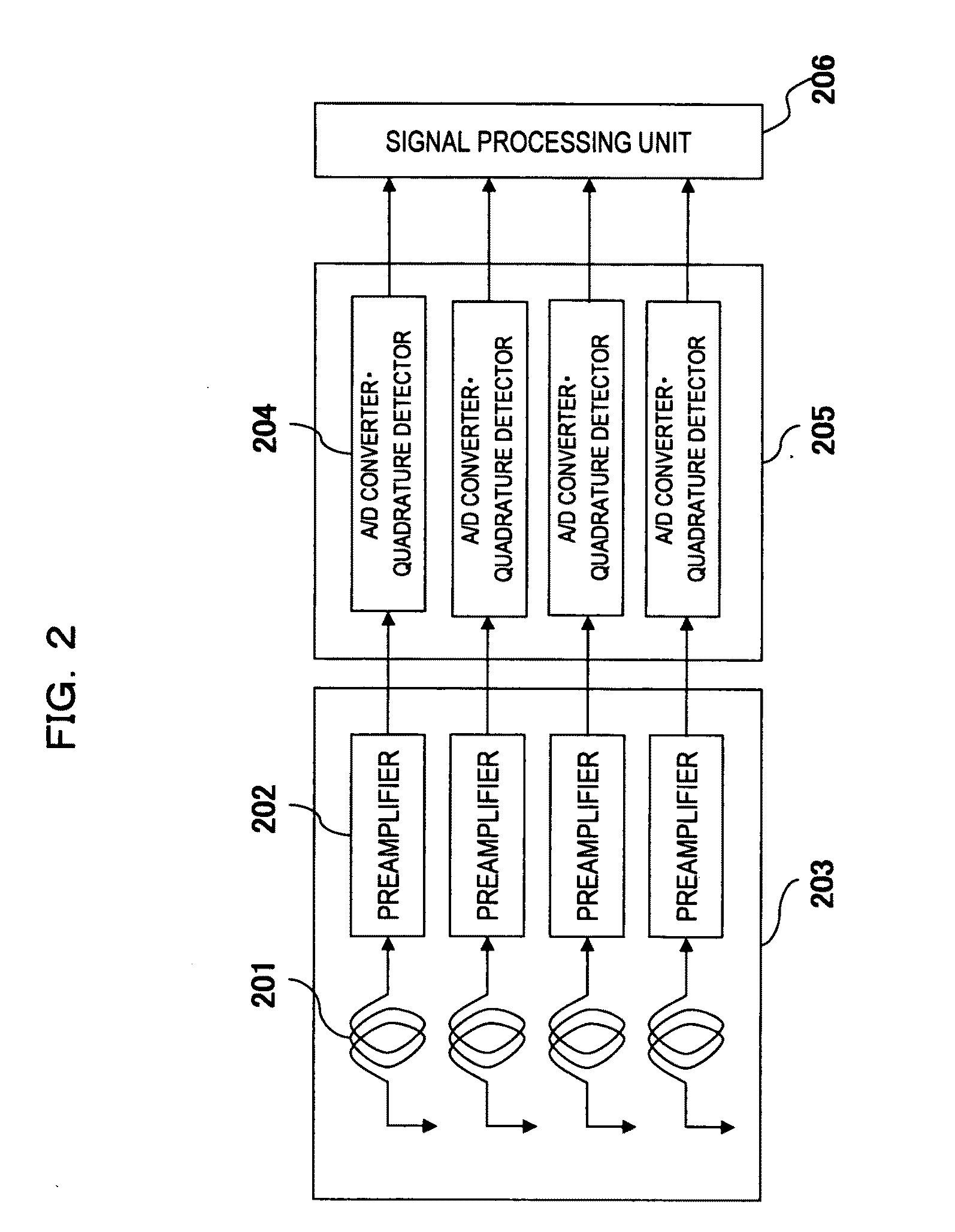Magnetic Resonance Imaging Apparatus and Method
- Summary
- Abstract
- Description
- Claims
- Application Information
AI Technical Summary
Benefits of technology
Problems solved by technology
Method used
Image
Examples
embodiment 1
[0055]First, an example of the pulse sequence to be applied in embodiment 1 will be described referring to FIG. 4. The pulse sequence shown in FIG. 4 is a spin echo method, irradiation of RF pulse 401 and gradient magnetic field pulse 402 for slice selection are simultaneously applied first, and only the target fault plane is excited. Next, gradient magnetic field pulse 403 for phase encoding is applied in order to encode the positional information. Then the phase of proton dispersed over time is inverted 180 degrees, the phases are aligned again, and RF pulse 404 and gradient magnetic field pulse 405 for slice selection are irradiated to cause the echo signals generated.
[0056]Finally, gradient magnetic field pulse 406 for signal readout is applied, and the echo signals are collected as indicated by 407.
[0057]FIG. 5 is a schematic view showing the case of calculating sensitivity information (sensitivity distribution) of the respective small RF receiver coils in embodiment 1 of the p...
embodiment 2
[0101]Next, embodiment 2 will be described. Embodiment 2 is another example of weighting function used in step 1005 of embodiment 1. The function to be used in embodiment 2 is referred to as the piecewise linear function, and represented in the following formula 26 and in FIG. 13. In this regard, however, when formula 26 is expressed in a general formula, it will be expressed as formula 27.
β(x,y)=1 (r′(x,y)<1)
β(x,y)=−1 / 2×r′(x,y)+2 (1≦r′(x,y)≦=3)
β(x,y)=0 (3<r′(x,y)) [Formula 26]
η=1 (λa)
η=−c×λ+a×c+1 (a≦λ≦a+1 / c)
η=0 (a+1 / c<λ) [Formula 27]
[0102]In formula 27, “a” is a starting point of the linear function, and “c” is a slope of the linear function (sign inversion). When the piecewise linear function in this embodiment is used, the weighting coefficient can also be obtained by making the change of the matrix elements in sensitivity distribution small in the region having high signal intensity in the whole sensitivity image, and by making the change of matrix in sensitivity distributi...
embodiment 3
[0103]Next, embodiment 3 will be described. Embodiment 3 is another example of the weighting function to be used in step 1105 of embodiment 1. The function to be used in embodiment is referred to as the piecewise cosine function, and is represented in the following formula 28 and in FIG. 14. In this regard, however, formula 28 is expressed as formula 29 when expressed in general formula.
β(x,y)=1 (r′(x,y)<1)
β(x,y)=0.5+0.5×cos(π / 2*(r′(x,y)−1)) (1≦r′(x,y)≦3)
β(x,y)=0 (3<r′(x,y)) [Formula 28]
η=1 (λa)
η=0.5+0.5×cos(η / *(λ−a)) (a≦λ≦a+d)
η=0 (a+d<λ) [Formula 29]
[0104]In formula 29, “a” represents a starting point of the cosine function, and “d” represents the range of the cosine function. When the piecewise cosine function in the present embodiment is used, the weighting function can also be obtained by making the change of the matrix elements in sensitivity distribution small in the region having high signal intensity in the whole sensitivity image, and by making the change of matrix ele...
PUM
 Login to View More
Login to View More Abstract
Description
Claims
Application Information
 Login to View More
Login to View More - R&D
- Intellectual Property
- Life Sciences
- Materials
- Tech Scout
- Unparalleled Data Quality
- Higher Quality Content
- 60% Fewer Hallucinations
Browse by: Latest US Patents, China's latest patents, Technical Efficacy Thesaurus, Application Domain, Technology Topic, Popular Technical Reports.
© 2025 PatSnap. All rights reserved.Legal|Privacy policy|Modern Slavery Act Transparency Statement|Sitemap|About US| Contact US: help@patsnap.com



